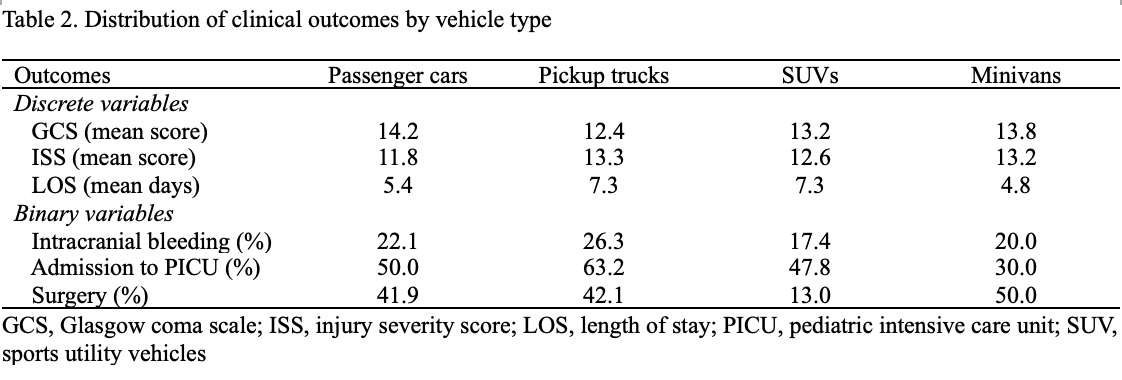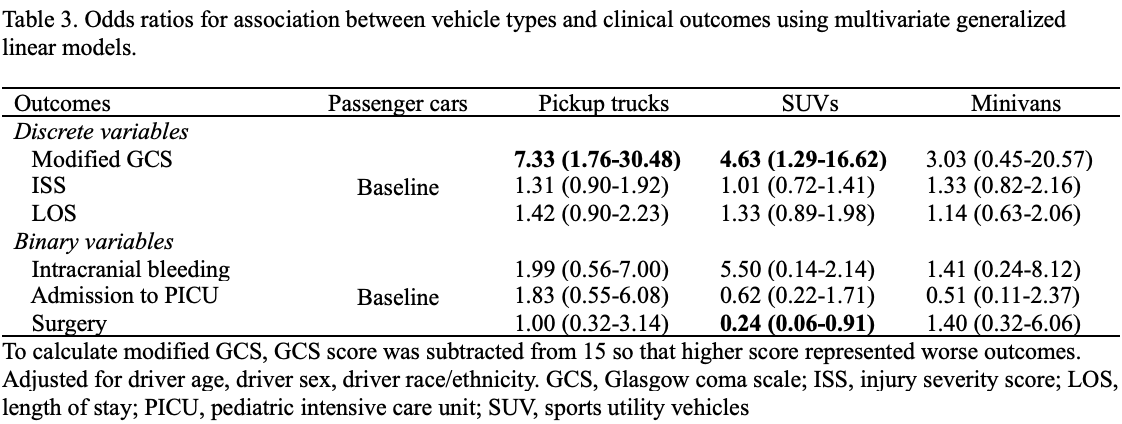Emergency Medicine 11
Session: Emergency Medicine 11
523 - Clinical outcomes of pedestrian victims in motor vehicle collisions by vehicle type
Monday, April 28, 2025
7:00am - 9:15am HST
Publication Number: 523.4218
Jewel Park, Los Angeles General Medical Center/University of Southern California, Los Angeles, CA, United States; Wayne Kuang, Los Angeles General Medical Center / University of Southern California, Los Angeles, CA, United States; Jaclynn Kovach, Los Angeles General Medical Center, Los Angeles, CA, United States; Daniel Im, USC, Los Angeles, CA, United States

Jewel Park, MD, M.P.H.
Physician Postgraduate
Los Angeles General Medical Center/University of Southern California
Los Angeles, California, United States
Presenting Author(s)
Background: In pedestrian injuries due to motor vehicle collisions (MVC), prior research has shown increased morbidity or mortality with vehicle types of larger size, such as sports utility vehicles (SUVs) or pickup trucks. However, history regarding vehicle type is often not collected in clinical settings, presumably because it is uncertain how vehicle type impacts clinical outcomes.
Objective: To explore how vehicle types affect clinical outcomes in pedestrian victims of motor vehicle collisions.
Design/Methods: We collected data for all pedestrian victims (including bicycles, skateboards, scooters, and strollers) aged 0 to 18 who visited the emergency department (ED) after a MVC at the Los Angeles General Medical Center between January 2017 and December 2022. We matched patient records to the Statewide Integrated Traffic Records System (SWITRS) database collected by the California Highway Patrol (CHP) to determine which vehicle type was involved. We manually matched patient records using patient age, sex, time of collision, and location of MVC. Only MVCs that involved 4 vehicle types (passenger cars, SUVs, pickup trucks, minivans) were included. Multivariate general linear models were created to calculate odds ratios between vehicle types and clinical outcomes, including the Glasgow coma scale (GCS), injury severity score (ISS), length of stay (LOS), intracranial bleeding, admission to the pediatric intensive care unit (PICU), and receiving surgery, adjusting for driver sex, age, and race; binomial distribution was used for binary variables and negative binomial distribution for discrete variables.
Results: Out of 219 pedestrian victims who visited the ED during our study period, 164 had matching records in the SWITRS database, and of these, 138 records that contained information regarding vehicle type were included in our study. Of all collisions, 61.8% involved passenger cars, 16.9% SUVs, 14.0% pick-up trucks, and 7.4% minivans. Overall, victims struck by pickup trucks had worse clinical outcomes compared to those struck by passenger cars. Compared to passenger cars, pickup trucks (OR 7.33, 95%CI 1.76-30.48) and SUVs (OR 4.63, 95%CI 1.29-16.62) were significantly associated with worse GCS scores, while SUVs had decreased odds of receiving surgery (OR 0.24, CI 0.06-0.91).
Conclusion(s): Clinical outcomes for pedestrian victims involved in MVCs can vary significantly depending on the involved vehicle type. Future studies with a larger study population are indicated to observe to generalize these findings.
Table 1. General characteristics of the study population.
.png)
Table 2. Distribution of clinical outcomes by vehicle type.

Table 3. Odds ratios for the association between vehicle types and clinical outcomes using multivariate generalized linear models.


